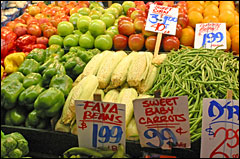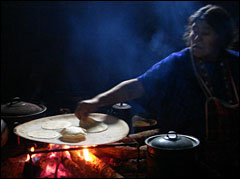Not long ago, a reader wrote in with an interesting response to one of my many articles condemning industrially grown corn.

Yes, you can buy it!
Photo: iStockphoto
“When sweet corn appears at the farmers’ market next summer, can I buy it in good conscience?” she wanted to know. “Or is it bad for me and bad for the land?”
I can see why she might be confused. Even as U.S. farmers prepare for what will almost certainly be the largest concentrated corn harvest in world history, criticism has rained down like fertilizer on an Iowa corn patch. Michael Pollan placed corn at the center of what he called “our national eating disorder” in his best-selling Omnivore’s Dilemma. I’ve personally joined the chorus tying corn to everything from the obesity epidemic to the Gulf of Mexico dead zone, and to the “biggest greenwash ever,” ethanol.
Next thing you know, I’ll be trying to link corn to the calamities unfolding in Iraq. Wait — someone already has. Global warming? Ditto.
Thus corn is, in some sense, bad — evil, even. But before we shuffle this common crop into the ash heap of history — where it will reside next to cigarette smoking and other indecencies — it might be time to rethink the process by which we embrace and then demonize food and other substances we ingest.
I’ve identified an insidious pattern in U.S. food culture: Take a perfectly wonderful foodstuff, industrialize its production and strip it of most nutrients, sell it in titanic quantities, create a health scare — and then demonize it. It’s the process through which what’s good for you becomes bad.
Beyond Good and Evil
Consider the case of butter. When I was a kid in the 1970s, a near-hysteria to ban butter from home kitchens held sway. Butter raised cholesterol, the logic went, and thus caused heart disease. Better to slather your toast with margarine — vegetable oil contrived to remain solid at room temperature by an industrial process called “partial hydrogenation.” Obeying the best health information available to them, my parents stuck mainly to margarine, backsliding to the natural product only occasionally.
Of course, the demonization of butter wasn’t completely irrational. I remember how copiously my grandparents used butter. It went on everything: bologna was fried in it, and then placed between two well-buttered slices of white bread. I don’t recall lettuce or any other vegetables going on those sandwiches; a slice of “American cheese” was more likely. They even buttered Pop-Tarts! Meanwhile, dairy operations were just beginning to confine lactating cows in feedlots en masse and replace grass-based diets with grain, a feeding strategy we now know reduces the quality of the fat contained in dairy products.
At the time, heart-disease rates were surging. But rather than advising people to moderate butter consumption or evaluating these new methods of dairy production, the U.S. medical establishment urged consumers to switch to a synthetic substitute that the food industry was only too happy to produce.
With margarine, you could slather your toast with fat guilt-free. But no one, including my grandparents, did themselves a favor by switching to partially hydrogenated fat — one foodstuff that may truly qualify as demonic. Not surprisingly, by the 1980s, when it became clear that the switch to margarine wasn’t curtailing heart-disease rates, a backlash against fat itself gained force.
This culminated in one of the most ignominious phases of U.S. culinary history: the “low-fat” craze. And once again, industrial food was there to help.
Up and down the supermarket aisle, food processors hawked “low-fat” versions of everything they could think of: pudding and cake and potato chips and breakfast cereal. Remember low-fat ice cream? I can even recall seeing the phrase “fat-free” screaming from a can of frozen, concentrated orange juice — as if oranges had fat anyway.
The low-fat fad may mark the last instance when consumers really believed that food-processing conglomerates could actually improve the raw food that grows from the dirt. For me, the trend peaked when I found a jar of something called “fat-free guacamole” in my mother’s fridge in the early 1990s. Guys in white lab coats, employed by who knows what industrial-food titan, had “perfected” the avocado by stripping it of fat. Never mind that the very fat they trashed is precisely what makes avocados an incredibly delicious and health-giving food.
False Choices
My mother, to her credit, has long since rejected “low-fat” processed garbage. Indeed, there’s a growing understanding that the food industry offers mostly false choices: between, say, cheap, nutritionally suspect butter from corn-stuffed cows, and equal amounts of heart-wrecking butter-like “spread.” Our butter-margarine journey is just one example of such choices — even beer and cigarettes, justly demonized in the form of Miller Lite and Marlboro, started out as relatively benign agricultural products before industry got to them.
Now people are relearning a lesson that’s been largely forgotten since the post-war explosion of industrial food: that quality matters — and that food quality derives from growing practices. Butter made from the milk of grass-fed cows, for instance, is fundamentally different from the stuff churned out in vast quantities by the mega-dairy operations.
Moreover, the idea that moderation trumps substitution with synthetic knockoffs is gaining traction. Even the most pristinely produced butter will likely cause harm if you add a thick layer to everything you eat. But a bit of well-made butter spread on freshly baked bread, or baked into biscuits for a weekend treat — those are sublime experiences that hardly threaten health.
The key is respect. Butter is a powerful, nutritionally dense food, and needs to be treated as such. Which brings us back to corn.
Widely regarded as one of the great triumphs in the history of plant domestication, corn nourished the thriving cultures of Mesoamerica for millennia. Even today, despite contamination from genetically modified U.S. seeds, Mexico harbors a dizzying variety of corn types. Its citizens who follow a traditional diet, based on flavorful varieties of whole corn processed into tortillas using an ancient method, remain significantly healthier than other Mexicans who embrace a U.S.-style diet.
So we can’t blame Mexico’s “food of the gods” for our surging obesity, our damaged farmland, or our troubled gulf waters. Our problem doesn’t stem from corn, but rather the abusive way we grow it, process it, and put it into nearly everything on our supermarket shelves. When they’re selling corn on the cob at the farmers’ market this summer, embrace it. You can be sure it’s a different variety from the mass-produced stuff — and bred for flavor, not ease of processing.
¡ Viva el maíz ! May it survive the U.S. food system’s deadening embrace.



